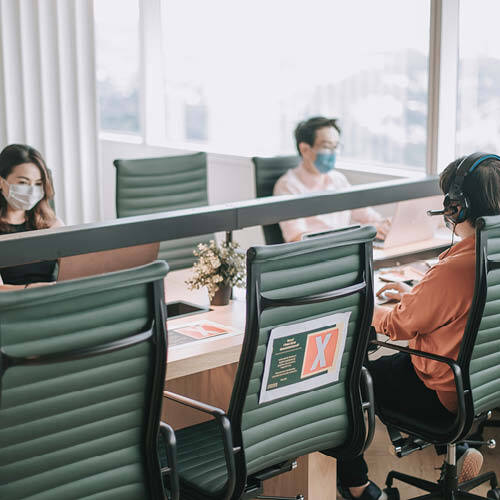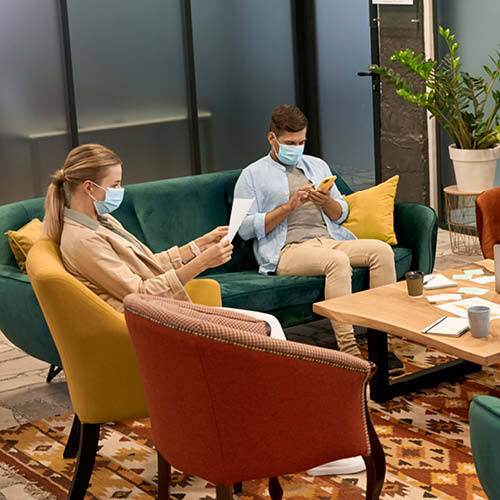The role and therefore the environment within an office is changing to meet the new needs of customers and employees.
The workplace has been undergoing profound change for the last twenty years. The arrival of the Apple iPhone and powerful mobile computing was swiftly followed by enterprise cloud computing. In turn, these trends led to the digitization of business models, consumer habits, and, therefore, the way we work. An acceleration of pace took place; those cloud-enabled mobile devices made each and every one of us impatient; we expected information and services instantly and digitally. The previous epoch of technology development couldn’t keep pace, and Agile, iterative methods have proved to be more effective for digitization. The workplace is not, though, entering a phase of stability; recent events have pushed the foot down harder on the accelerator for digitization. As a result, the workplace will once again change lanes, and CXO will be in the driving seat.
The office will have to adapt to meet the changing demands of employees, who are, of course, altering the way they work to meet the new requirements being laid down by the customer. Agile and iterative ways of working have been proven effective. Prior to the arrival of enterprise cloud computing, there had been a phase of major enterprise outsourcing, but cloud and the pace of digitization have led to internal technology teams. Digital development has created to the rise of the cross-functional team; no longer do business lines inform IT of a need, which is followed by a requirements gathering process and then development by IT or its suppliers before delivery. This process - which often took months and years - led to business requirements changing before a technology project was completed. Today, those that will use the technology also play a vital role in its development and its continued improvement.
“After three years we have over 20 teams in six locations who all operate in the same way,” banking CTO Jack Bennie says of how the short sprints of development and continuous delivery cycles have become a de facto operating model in Canada, India, Poland, and the UK. “The success this model can have is exciting, as it breeds a culture that fulfills itself and perpetuates,” the CTO says. “What I love about what we have created is that people have a sense of ownership and pride in what they have delivered. The balance doesn’t work unless you have a leadership environment that provides empowerment, and if you do, you can build a truly cross-functional team.”
“Great companies create new operating models and remodel their business frequently,” write Fin Goulding and Haydn Shaughnessy in their book Transformation Sprint. The authors recently discussed their work on the Cloud Counsel, describing how the sharing of functions and outcomes is the route to success. This in turn leads to a necessary reimagining of the workplace. Flexible office spaces are required to ensure it is easy for business lines to accommodate technologists, collaborative spaces, and the technologies that support this activity.

What The Office Must Offer
This sea change in the way that the organization works means that the office is now no longer the only place that works is completed. Instead, the office has to be the place where the most valuable and collaborative work is done, where teamwork is fostered and achieved. As we have seen in the last year, individual work no longer has to be tied to a place or even a time.
“Because we all need to work at home at times, I want to create an atmosphere where I want you to think, ‘damn, I missed out today’ if you weren’t in the office. This is a vital part of being a modern company,” the CIO of a global oil firm says of his aspirations for the redevelopment of his headquarters. “This is about beating startups, who are all over this from a point of creativity and huddling together and driving something.”
James Thomas, CTO for global health research body the Wellcome Trust had to ensure an innovation culture developed. “We created microteams that brought people from projects and operations together, and we made them contiguous; they owned their own success and set their agenda,” he says of how they worked together. Wellcome has been modernizing its core technology stack, moving its infrastructure to the cloud, and adopting Microsoft Office365 to provide the tools for microteams to
collaborate on, whether they are in the office or remote.
“We had 350 staff in six sites and then 350 staff in 350 sites, but the Nutanix VDI environment really worked,” says Jon Cosson, Head of IT and CISO with JM Finn, a financial services provider. Cosson, like his peers, found that the VDI technology enabled work to continue, despite a global pandemic. With remote working having proven its worth in 2020, CXOs will seek to lower building operating costs whilst also reimagining the role of the office.
“I think there will be a desire for mixed-mode meetings,” says Mark Davies, a government sector CIO in the UK. The CIO says his role now is to guarantee that the infrastructure is in place to ensure government workers can work on-site or remotely with secure and increasing access to data to drive decision making. Davies is amongst a growing number of CXOs that are now helping their organizations change, as they realize that full-time office-based work is not economically viable or the culture that the business requires.

The CXO of an international transport firm says too many organizations overlook the importance of being physically together when the business adopts Agile methods, and despite the ceremonies concept of working remotely, physical interactions are far more powerful. In a redesign of the headquarters, the business adopted an open plan but used the neighborhood approach, which meant that teams sit together in communities because they need to work closely on an almost daily basis. The CXO adds that this improves the quality of Agile methods.
As part of the rethink of the office, CXOs will need to consider all members of the organization, not just those in knowledge-based roles. Anna Barsby, CIO with a major supermarket chain, says equality for those remote, on-site, and in the office has to be achieved.

Additional Content

ARTICLE
The Benefits of DBAAS Without Vendor Lock-in? Yes, It's Possible

Article
Remote Leadership Requires a New Closeness







